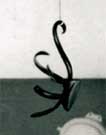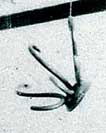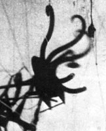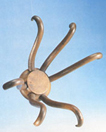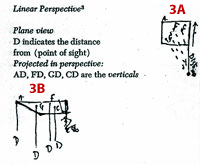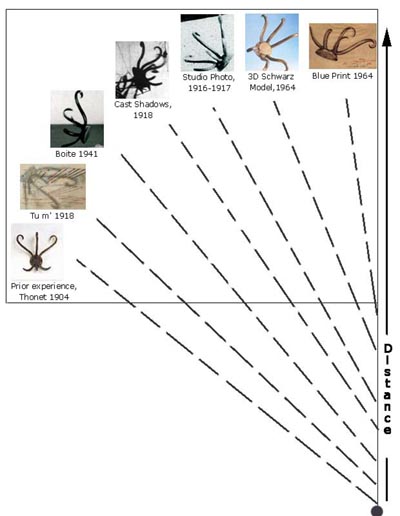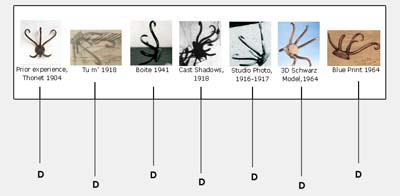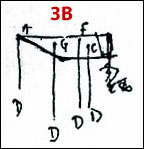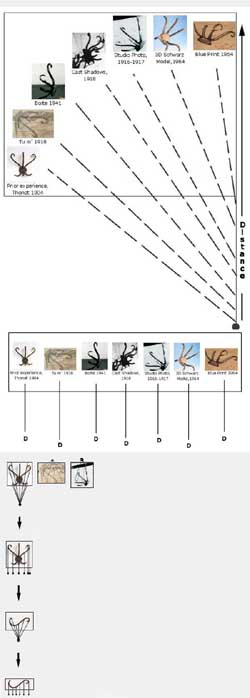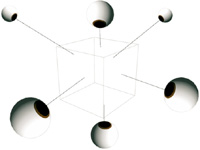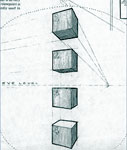|
page1
|
|
Why
the Hatrack is and/or is not Readymade: by Rhonda Roland Shearer with Gregory Alvarez, Robert Slawinski, Vittorio Marchi and text box by Stephen Jay Gould
* Article Part IV through VI will be published in Tout-Fait, Perpetual 2005. <PART I> |
|||||||||||||||||||||||||||||||||||||||||||||||||||||||||||||||||||||||||||||||||
|
Duchamp states in
notes written between 1911-15 (see illustration 1, showing Duchamp's
Green Box Note published in 1934) that the time and date of his
readymades is important "information" in addition to the "serial
characteristic of the readymade."(1)
The "snapshot
effect"(2)
of this timing of the readymade, to which Duchamp refers in this note,
makes sense when we examine Duchamp's readymades with his mathematical
notes (written 1911-15 but held back for publication by Duchamp until
1967, a year before his death.)(3)
First, let us begin
by "looking" at Duchamp's readymades through time. Since Duchamp
claims that he "lost" most of his original readymade objects,
Duchamp's 1915 hatrack, as well as his urinal, snow shovel, coatrack,
bottlerack and bicycle wheel and stool, exist only in a series of varied
representations given to us by Duchamp over an extended period of time.
As an example, the
following time-line illustrates the sequence of appearances of Duchamp's
"lost" hatrack. We see "the serial characteristic of
the Readymade" just as Duchamp described in a presentation of his
"Readymade" (the title he used for his hatrack in the 1941
representation, see illustrations 2A, B, C, D, E, and F below).
Click each image to enlarge
Thus the tally of
Duchamp's hatrack representations is as follows: 2 2D shadows 2 2D photographic
images 1 2D blueprint
(1964) Indeed, with the paltry
set of data that Duchamp provides, the only physical or mental construction
we can make, based upon the hatrack's original form, is by fusing or
averaging and filling in among the 6 representations previously listed
-- 5 images in 2D and 1 model in 3D. This procedure can be done mentally
via visualization, or physically via model-making, with conscious effort
on the part of spectators. However, interpreting 2D depictions, mentally
translating them into 3D, and then rotating and joining them (with visual
filling in), is not a skill equally possessed by everyone and has, in
fact, been frequently used as one measure of intelligence.(5)
Alternatively, if
we do not help ourselves by consciously combining the 6 hatrack depictions,
the result is an ad hoc, automatic conclusion or assumption-generated
"readymade" from the unconscious mind. A single depiction
-- such as the first Duchamp hatrack that we see in a photograph or
a print, or the 3D Schwarz model, or any one of a combination of Duchamp's
6 particular depictions -- has served to evoke in our minds a "general
idea of a Duchamp hatrack" that is surely derived from an uncertain
mixture taken from among Duchamp's 6 hatrack representations and our
prior experience with hatracks. Herein lies the key
to Duchamp's insight, conveyed within his In the Infinitive [a.k.a.
the White Box](1967) mathematical notes (1911-15). After identifying
the 6 representations that Duchamp has given us as 6 distinct and separate
snapshot views of his original hatrack, we have, essentially, a set
of 6 "cuts" or 2D parts taken from a larger set of information,
or the hatrack as a 3D whole. These 6 "cuts" are, in essence,
6 perspective views or observations. Each cut is also, itself, an "aggregate"
(made of parts) of additional "cuts" or observations -- ad
infinitum. In other words, to add more cuts to our set of 6 hatrack
representations, we must simply repeat our previous operation. Just
as we took 6 cuts (parts), beginning from our generality of Duchamp's
hatrack, we must now take these 6 cuts (now themselves a set or whole)
and cut each of these cuts into more cuts.
Duchamp clearly indicates
his grasp of this recursive nature of our mental operations in the White
Box Notes. Several drawings illustrate two perspectives that behave
as one process split into two alternating mental states. Our perspectives
mechanically move back and forth between the general (a single perspective
of the AGFC figure, see illustration 3A) to the particular (multiple
snapshots [cuts] or perspectives of A,G,F,C in a series over time, see
illustration 3B). Immediately after perspectives A,G,F and C are cut
as in figure 3B, we have created a new set that functions as a generality,
as in figure 3A. We then begin the cycle all over again, with more cuts
of this generality, then another generality, then cuts in a series,
again at finer and finer scales. Essentially, we are mentally and observationally
moving back and forth between states 3A and 3B -- wholes and parts at
different levels of details.
Step 4 of illustration
4C above answers the challenge previously mentioned: how do we add more
cuts to our limited set of 6 representations of Duchamp's hatrack?
When we actually take
Duchamp's hatracks representations and add the cuts (beyond merely identifying
the 6 snapshots as in step 2 in illustration 4C), we discover that every
one of the 6 representations (5 in 2D and 1 in 3D) is not, as we might
have expected, a single cut from the same 3D hatrack object. By way
of example, see illustration #5, if we reassemble all observations (cuts)
resulting from the set of all eye positions looking at this particular
cube, we would be able to predict, and easily to build, a symmetrical
cube object from the resulting limited set of cuts. Each cut, upon examination,
fulfills our expectation of a cube's form with its 6 faces, 12 edges
8 vertices -- all we have to do is just count them to confirm. Illustration
#6 depicts how the perspective distortions change according to the angle
of eye's observation of the cube. Our expectations are
not fulfilled upon examining the 6 hatrack snapshots. Not only are the
curvatures of the hooks different in all 6 representations, but we must
conclude that even the number of hooks varies after we count them. For
example, the Schwarz 3D model, (the "corrected" second version)
has 6 equal length hooks, symmetrically placed as 3 on one side and
3 on the other side of the base's circular form. In contrast, the blueprint
(approved and signed "okay, Marcel Duchamp") has a weird tangle
of 2 long and 3 short hooks. page1
|
|||||||||||||||||||||||||||||||||||||||||||||||||||||||||||||||||||||||||||||||||


